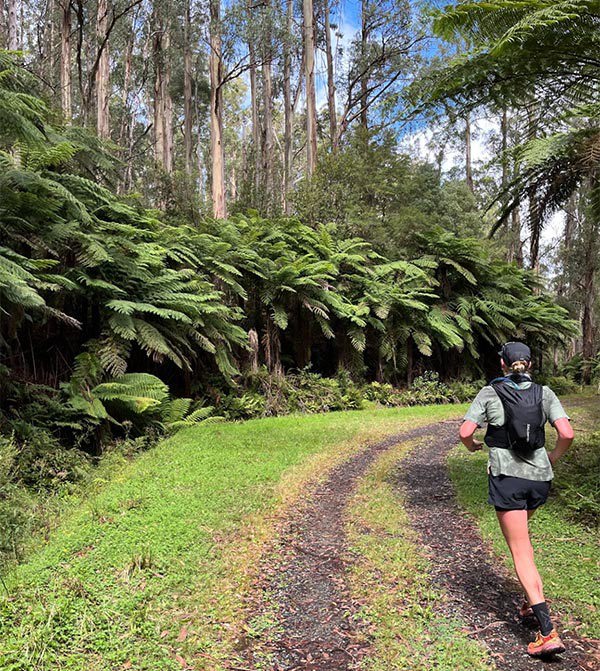The Importance of Strength for Trail Running: A Physiotherapist’s Perspective
24 March 2025

Trail running is an exhilarating sport that challenges the body in unique ways. Unlike road running, trails present varied terrain, steep inclines, uneven surfaces, and unpredictable obstacles. These elements require not only endurance but also strength. Elyse has dabbled in some trail running this year and has enjoyed exploring the crucial role that strength plays in performance enhancement, injury prevention, and overall resilience for trail running.
Why Strength Matters for Trail Running (and hiking. Because, lets face it, there's lots of walking in trail running)
Improved Stability and Balance
Running on uneven terrain demands superior balance and stability. Strengthening the core, hips, and lower limb muscles enhances proprioception and control, reducing the risk of falls and ankle sprains.
Enhanced Power and Endurance
Strength training, particularly for the glutes, quads, and calves, supports uphill running efficiency and downhill control. Stronger muscles reduce fatigue, allowing trail runners to maintain speed and performance over long distances.
Injury Prevention
Weak muscles can lead to biomechanical imbalances and overuse injuries such as knee pain, Achilles tendinopathy, and IT band syndrome. Targeted strength exercises improve muscular endurance and reduce strain on joints and tendons.
Better Shock Absorption
Trail running involves significant impact forces, especially during downhill sections. Strengthening key muscle groups, such as the quadriceps and calves, helps absorb shock, protecting the joints from excessive stress.
Key Strength Exercises for Trail Runners
To maximize strength for trail running, incorporating functional exercises into a training regimen is essential. Here are some of the most effective exercises:
- Single-Leg Squats – Enhance stability, knee alignment, and glute activation.
- Step-Ups – Mimic uphill running mechanics and strengthen the quads and glutes.
- Lunges (Forward, Lateral, and Reverse) – Improve dynamic balance and strength in multiple planes of motion.
- Calf Raises – Strengthen the calves to support push-off power and reduce Achilles strain.
- Core Work (Planks, Russian Twists, Dead Bugs) – Build a strong foundation for maintaining posture and stability on uneven terrain.
- Hip Flexor Strengthening – Improves hip flexion and extension, enhancing stride efficiency.
- Unilateral Hamstring Strength – Helps prevent muscle imbalances in the landing phase of running.
- Quadriceps Strengthening – Protects the knees and improves downhill control.
- Heavy Front Squats – Develops core, quad, glute, and postural strength.
- Hip Adduction Exercises – Prevents knee valgus, strengthens the hips, and improves alignment.
- Bulgarian Split Squats & Back Lunges – Builds unilateral triple extension strength to prevent compensatory movement patterns.
- Glute Medius Activation – Reduces IT band overuse and minimises strain on the knees.
Integrating Strength Training into Your Routine
Strength training should be incorporated strategically into your trail running (or hiking) routine. The frequency, timing, and intensity depend on individual goals, experience, and recovery capacity. Here are some key considerations:
Training Frequency
Most runners benefit from strength training 2-3 times per week, but this varies based on experience level and training load. Beginners may start with two sessions per week, while more experienced runners can include three sessions to further enhance strength and resilience.
Timing
Finding the right time to strength train depends on how your body responds to different workouts. Some runners prefer lifting on non-running days to avoid fatigue, while others incorporate it before or after a run. Testing different approaches will help determine what works best for you.
Progressive Loading
Start with bodyweight exercises to master form and movement patterns before gradually increasing resistance. Kettlebells, dumbbells, and barbells can be incorporated as strength improves.
Breakdown of a Well-Rounded Strength Routine:
- 10% Mobility – Prepares joints and muscles for movement.
- 10% Heavy Lifts – Builds overall strength and power.
- 10% Plyometrics & Explosive Work – Improves speed, reactivity and proprioception.
- 70% Single leg, Kettlebell & Accessory Work – Focuses on correcting imbalances and refining movement efficiency.
The emphasis on unilateral (single leg) and accessory work helps target smaller stabilising muscles, preventing compensation patterns and enhancing overall running efficiency.
Final Thoughts
Strength training should complement, not replace, trail running sessions. Aim for at least two strength-focused workouts per week, ensuring a balance between running volume and muscle recovery. Gradually increase resistance and intensity to avoid overloading the body.
If you’re looking for personalised strength programs tailored to your trail running goals, book an appointment with us today!




